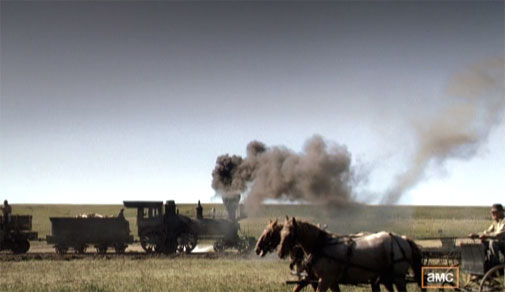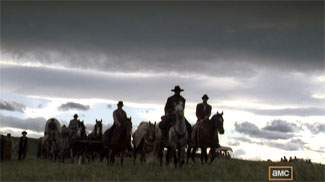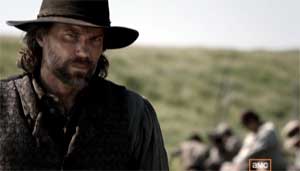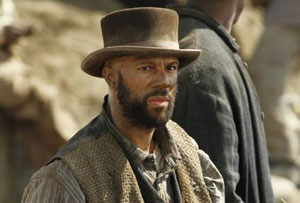
Westerns got serious when Hollywood started to show just how bedraggled towns were in the era that preceded pavement.
Comes now -- far from the sunny, spotless sets on Hollywood back lots -- Hell on Wheels, approaching the midway point of its first-season run, 10 p.m. ET Sundays on AMC. Another aspect of the sunny back lots of classic Westerns was the monochrome casts. Hell on Wheels buries that historic slight in the muck of a struggling railroad town that serves well as a metaphor for America's westward settlement.
So too comes this census: whites, blacks, American Indians, European immigrants and references to Asians. What an opportunity to lay out the sociopolitical map that has become modern-day America.

Think about it. What would a nation, hard on the heels of civil war, do to reinvent itself? Follow Horace Greeley's dictum, of course. The stentorian political reform advocate who founded the New York Tribune exhorted the youthful and adventurous to "Go West, young man."
In fact, that was borrowed from advice given in 1851 by Indiana newspaper writer John Soule. It became the clarion call for 19th-century U.S. migration. Expansion to the Appalachians had been the great move of the 18th century. For the 19th, the Rockies were in adventurers' crosshairs.
The richly diverse cast of Hell on Wheels includes a cliched roll call of stock characters: the corrupt railroad owner, the profoundly flawed Confederate veteran, the grieving but keenly savvy widow, the cardboard cutout immigrants, the incessantly angry ex-slaves, the corrupt middle manager, the abolitionist turned preacher, the Christian American Indian, and lordy, what or who else.
But don't get thrown by the seemingly stock characters. The setting and sometimes frightening setups grab attention. Moreover, the story lines buried in layers of the script reveal stirring background stories, much in the same way that peeling layers of an onion releases flavor.

Maybe patience is what's required for viewers to appreciate Hell on Wheels. In several instances, viewers are likely to pause with questions -- mostly why-prefaced. The dialogue eventually offers answers, almost as a backstory told without visuals.
The first answer was the motivation of the Confederate (Anson Mount as Cullen Bohannon, right) for his killing spree. In this case, there are gauzy dream sequences, and the remnant of a sampler stitched by his wife. Then we learn -- in part, at least, so far -- why the widow (Dominique McElligott as Lily Bell) is so furtive about her husband's maps and charts.
As the dialogue unfolds, we get other answers, too -- but again, in part: the American Indian's (Eddie Spears as Joseph Black Moon) motivation to convert to Christianity, and the Rev. Nathaniel Cole's (Tom Noonan) quest for redemption.
In some ways, Hell on Wheels is a walk -- one step forward, two steps back -- through what has gone wrong in America. Why, for instance, was it necessary to replicate racial discrimination in the West? For a generation that just saw that movie and its outcome in the South, why would westward expansion attempt practices that mimic slavery? And how could they succeed? And how could the immigrants, who just fled some of the worst mistreatment dished out by whites toward whites, turn against blacks?

The payoff in Hell on Wheels is a fascinating story with historic underpinnings. On tap are revelations about freed slave Elam Ferguson (played by Common, right) and his complex relationship with both blacks and whites. And how can viewers not be curious about The Swede (Christopher Heyerdahl), whose ascetic life towers in contrast to the chaos, filth and anarchy of Hell on Wheels?
Even though patience is not rooted in the DNA of television audiences, this series is sure to gain steam as the railroad moves west. Go easy on those thumbs before engaging TV remotes.
The history lesson isn't complete yet.